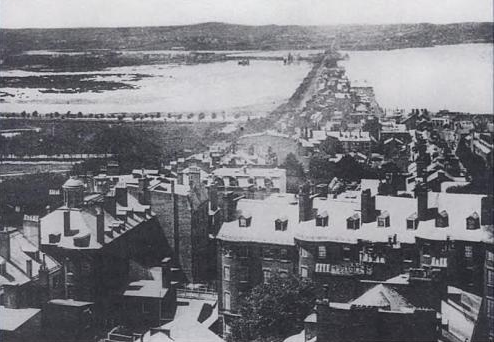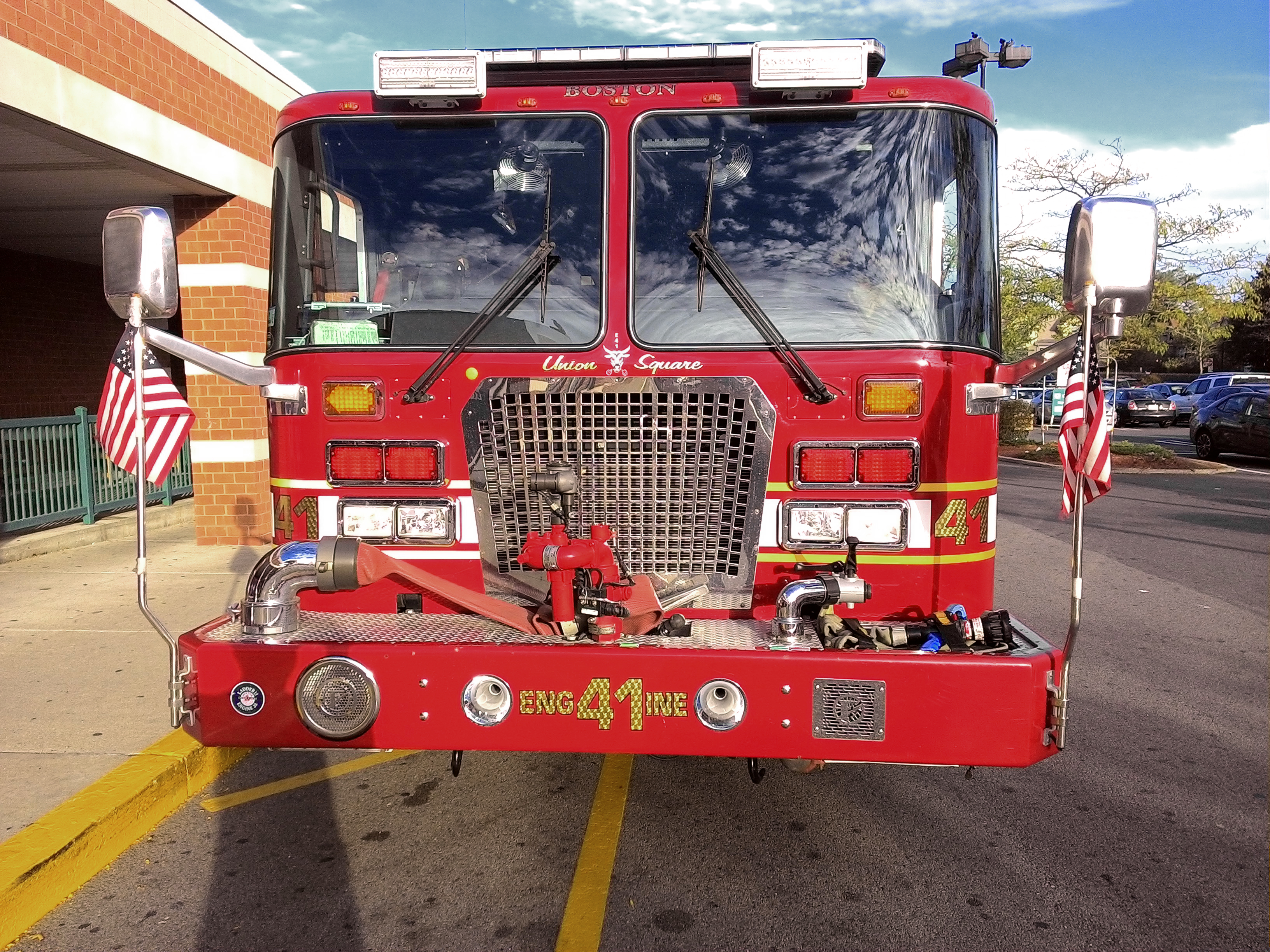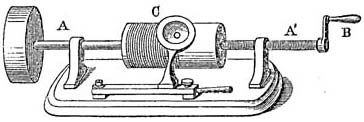|
Boston Elevated Railway Company
The Boston Elevated Railway (BERy) was a streetcar and rapid transit railroad operated on, above, and below, the streets of Boston, Massachusetts and surrounding communities. Founded in 1894, it eventually acquired the West End Street Railway via lease and merger to become the city's primary mass transit provider. Its modern successor is the state-run Massachusetts Bay Transportation Authority (MBTA), which continues to operate in part on infrastructure developed by BERy and its predecessors. History Originally intended to build a short electric trolley line to Brookline, the West End Street Railway was organized in 1887. By the next year it had consolidated ownership of a number of horse-drawn streetcar lines, composing a fleet of 7,816 horses and 1,480 rail vehicles. As the system grew, a switch to underground pulled-cable propulsion (modeled after the San Francisco cable cars) was contemplated. After visiting Frank Sprague and witnessing the Richmond, Virginia sy ... [...More Info...] [...Related Items...] OR: [Wikipedia] [Google] [Baidu] |
Shore Line Trolley Museum
The Shore Line Trolley Museum is a trolley museum located in East Haven, Connecticut. Incorporated in 1945, it is the oldest continuously operating trolley museum in the United States. The museum includes exhibits on trolley history in the visitors' center and offers rides on restored trolleys along its track as the Branford Electric Railway. In addition to trolleys, the museum also operates a small number of both trolleybuses and conventional buses. The museum encompasses the Branford Electric Railway Historic District, which was added to the U.S. National Register of Historic Places in 1983. History The museum was incorporated in August 1945 as the Branford Electric Railway Association (BERA), a non-profit historical and educational institution. The Connecticut Company (or ConnCo), which operated most of the streetcar lines in the state of Connecticut, had been making plans since the early 1930s to abandon its "F" route, cutting it back in stages from its long-time terminus ... [...More Info...] [...Related Items...] OR: [Wikipedia] [Google] [Baidu] |
Frank Sprague
Frank Julian Sprague (July 25, 1857 in Milford, Connecticut – October 25, 1934) was an American inventor who contributed to the development of the electric motor, electric railways, and electric elevators. His contributions were especially important in promoting urban development by increasing the size cities could reasonably attain (through better transportation) and by allowing greater concentration of business in commercial sections (through use of electric elevators in skyscrapers). He became known as the "Father of Electric Traction". Demonstrating an aptitude for science and mathematics, Sprague secured an appointment to the U.S. Naval Academy in 1874 and, after graduation in 1878 and 2 years at sea, resigned to pursue his career in electrical engineering. Early life and education Sprague was born in Milford, Connecticut, in 1857 to David Cummings Sprague and Frances Julia King Sprague, a school teacher His mother died when he was ten, and was sent by his father to li ... [...More Info...] [...Related Items...] OR: [Wikipedia] [Google] [Baidu] |
Megawatts
The watt (symbol: W) is the unit of power or radiant flux in the International System of Units (SI), equal to 1 joule per second or 1 kg⋅m2⋅s−3. It is used to quantify the rate of energy transfer. The watt is named after James Watt (1736–1819), an 18th-century Scottish inventor, mechanical engineer, and chemist who improved the Newcomen engine with his own steam engine in 1776. Watt's invention was fundamental for the Industrial Revolution. Overview When an object's velocity is held constant at one metre per second against a constant opposing force of one newton, the rate at which work is done is one watt. : \mathrm In terms of electromagnetism, one watt is the rate at which electrical work is performed when a current of one ampere (A) flows across an electrical potential difference of one volt (V), meaning the watt is equivalent to the volt-ampere (the latter unit, however, is used for a different quantity from the real power of an electrical circuit). : \mathr ... [...More Info...] [...Related Items...] OR: [Wikipedia] [Google] [Baidu] |
Distributed Generation
Distributed generation, also distributed energy, on-site generation (OSG), or district/decentralized energy, is electrical generation and storage performed by a variety of small, grid-connected or distribution system-connected devices referred to as distributed energy resources (DER). Conventional power stations, such as coal-fired, gas, and nuclear powered plants, as well as hydroelectric dams and large-scale solar power stations, are centralized and often require electric energy to be transmitted over long distances. By contrast, DER systems are decentralized, modular, and more flexible technologies that are located close to the load they serve, albeit having capacities of only 10 megawatts (MW) or less. These systems can comprise multiple generation and storage components; in this instance, they are referred to as hybrid power systems. DER systems typically use renewable energy sources, including small hydro, biomass, biogas, solar power, wind power, and geothermal power, an ... [...More Info...] [...Related Items...] OR: [Wikipedia] [Google] [Baidu] |
Power Grid
An electrical grid is an interconnected network for electricity delivery from producers to consumers. Electrical grids vary in size and can cover whole countries or continents. It consists of:Kaplan, S. M. (2009). Smart Grid. Electrical Power Transmission: Background and Policy Issues. The Capital.Net, Government Series. Pp. 1-42. * power stations: often located near energy and away from heavily populated areas * electrical substations to step voltage up or down * electric power transmission to carry power long distances * electric power distribution to individual customers, where voltage is stepped down again to the required service voltage(s). Grids are nearly always synchronous, meaning all distribution areas operate with three phase alternating current (AC) frequencies synchronized (so that voltage swings occur at almost the same time). This allows transmission of AC power throughout the area, connecting a large number of electricity generators and consumers and potential ... [...More Info...] [...Related Items...] OR: [Wikipedia] [Google] [Baidu] |
Electric Power Industry
The electric power industry covers the generation, transmission, distribution and sale of electric power to the general public and industry. The commodity sold is actually energy, not power, e.g. consumers pay for kilowatt-hours, power multiplied by time, which is energy. The commercial distribution of electricity started in 1882 when electricity was produced for electric lighting. In the 1880s and 1890s, growing economic and safety concerns lead to the regulation of the industry. What was once an expensive novelty limited to the most densely populated areas, reliable and economical electric power has become an essential aspect for normal operation of all elements of developed economies. By the middle of the 20th century, electricity was seen as a "natural monopoly", only efficient if a restricted number of organizations participated in the market; in some areas, vertically-integrated companies provide all stages from generation to retail, and only governmental supervision regul ... [...More Info...] [...Related Items...] OR: [Wikipedia] [Google] [Baidu] |
Back Bay, Boston, Massachusetts
Back Bay is an officially recognized neighborhood of Boston, Massachusetts, built on reclaimed land in the Charles River basin. Construction began in 1859, as the demand for luxury housing exceeded the availability in the city at the time, and the area was fully built by around 1900. It is most famous for its rows of Victorian brownstone homes—considered one of the best preserved examples of 19th-century urban design in the United States—as well as numerous architecturally significant individual buildings, and cultural institutions such as the Boston Public Library, and Boston Architectural College. Initially conceived as a residential-only area, commercial buildings were permitted from around 1890, and Back Bay now features many office buildings, including the John Hancock Tower, Boston's tallest skyscraper. It is also considered a fashionable shopping destination (especially Newbury and Boylston Streets, and the adjacent Prudential Center and Copley Place malls) and home ... [...More Info...] [...Related Items...] OR: [Wikipedia] [Google] [Baidu] |
Horse Car
A horsecar, horse-drawn tram, horse-drawn streetcar (U.S.), or horse-drawn railway (historical), is an animal-powered (usually horse) tram or streetcar. Summary The horse-drawn tram (horsecar) was an early form of public rail transport, which developed out of industrial haulage routes that had long been in existence, and from the omnibus routes that first ran on public streets in the 1820s{{{citation needed, date=February 2022, using the newly improved iron or steel rail or ' tramway'. They were local versions of the stagecoach lines and picked up and dropped off passengers on a regular route, without the need to be pre-hired. Horsecars on tramlines were an improvement over the omnibus, because the low rolling resistance of metal wheels on iron or steel rails (usually grooved from 1852 on) allowed the animals to haul a greater load for a given effort than the omnibus, and gave a smoother ride. The horse-drawn streetcar combined the low cost, flexibility, and safety of an ... [...More Info...] [...Related Items...] OR: [Wikipedia] [Google] [Baidu] |
Green Line A Branch
The A branch or Watertown Line was a streetcar line in the Boston, Massachusetts, area, operating as a branch of the Massachusetts Bay Transportation Authority Green Line. The line ran from Watertown through Newton Corner, Brighton, and Allston to Kenmore Square, then used the Boylston Street subway and Tremont Street subway to reach Park Street station. Portions of the route were built as horsecar lines between 1858 and 1880. The segment between and was electrified in 1889 as part of the Beacon Street line. By 1896, electric routes ran from Newton Corner (Nonantum Square) to downtown Boston via Brighton and via Watertown. Brighton service was extended to Watertown in 1912. The line was operated until 1969, when it was replaced by MBTA bus route 57, though it remained in service for non-revenue moves to Watertown Yard until 1994. History Formation Construction of the Brighton Horse Railroad, a horse car street railway, began in 1858. The line began at Central Square ... [...More Info...] [...Related Items...] OR: [Wikipedia] [Google] [Baidu] |
Allston, Boston, Massachusetts
Allston is an officially recognized neighborhood within the City of Boston, Massachusetts, United States. It was named after the American painter and poet Washington Allston. It comprises the land covered by the zip code 02134. For the most part, Allston is administered collectively with the adjacent neighborhood of Brighton. The two are often referred to together as "Allston–Brighton". Boston Police Department District D-14 covers the Allston-Brighton area and a Boston Fire Department Allston station is located in Union Square which houses Engine 41 and Ladder 14. Engine 41 is nicknamed "The Bull" to commemorate the historic stockyards of Allston. Housing stock varies but largely consists of brick apartment buildings, especially on Commonwealth Avenue and the streets directly off it, while areas further down Brighton Avenue, close to Brighton, are largely dotted with wooden triple-deckers. Lower Allston, across the Massachusetts Turnpike from the southern portion of Allston ... [...More Info...] [...Related Items...] OR: [Wikipedia] [Google] [Baidu] |
List Of IEEE Milestones
The following timeline tables list the discoveries and inventions in the history of electrical and electronic engineering. History of discoveries timeline History of associated inventions timeline List of IEEE Milestones The following list of the Institute of Electrical and Electronics Engineers (IEEE) milestones represent key historical achievements in electrical and electronic engineering. Prior to 1870 *1745–1746 – Leyden jar capacitor by Ewald Georg von Kleist and Pieter van Musschenbroek * 1751 – Book '' Experiments and Observations on Electricity'' by Benjamin Franklin * 1757–1775 – Benjamin Franklin's Work in London * 1799 – Alessandro Volta's Electrical Battery Invention * 1836 – Nicholas Callan's Pioneering Contributions to Electrical Science and Technology * 1828–1837 – Pavel Schilling's Pioneering Contribution to Practical Telegraphy * 1838 – Demonstration of Practical Telegraphy * 1852 – Electric Fire Alarm System * 1857 – Heinrich Ge ... [...More Info...] [...Related Items...] OR: [Wikipedia] [Google] [Baidu] |
Thomson-Houston
The Thomson-Houston Electric Company was a manufacturing company which was one of the precursors of the General Electric company. History The Thomson-Houston Electric Company was formed in 1882 in the United States when a group of Lynn, Massachusetts investors led by Charles A. Coffin bought out Elihu Thomson and Edwin Houston's American Electric Company from their New Britain, Connecticut, investors. The company moved its operations to a new building on Western Ave. in Lynn, Massachusetts, because many of the investors were shoe manufacturers from Lynn. Elihu Thomson Papers at the American Philosophical Society Charles A. Coffin led the company and organized its finances, marketing, and sales operations. Elwin W. Rice organized the manufacturing facilities, and Elihu Thomson ran the Model Room which was a precursor to the industrial research lab. With their leadership, the company grew into an enterprise with sales of and 4000 employees by 1892. In 1884 Thomson-Houston I ... [...More Info...] [...Related Items...] OR: [Wikipedia] [Google] [Baidu] |







